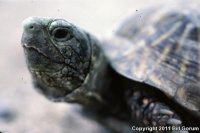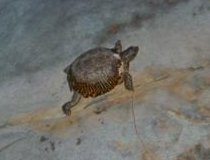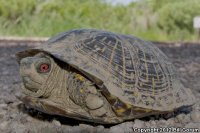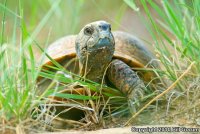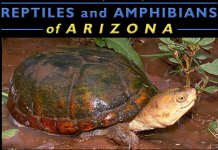| Range: |
 |
| Other Names: |
|
| Description: |
A small (shell up to 146 mm or 5.75" in length) land turtle with a high, dome shaped shell marked with radiating yellow lines on a dark background. As the animal ages the shell becomes lighter in color and the yellow lines fade. Older adults often have a plain yellow-brown shell. Adult males usually have red or orange-red irises and the first nail on each hind foot is curled inward. Adult females usually have orange-brown or yellow irises. The bottom of the shell (plastron) is hinged so that it can close like a box around the turtle. |
| Similar Species: |
The closely related Ornate Box Turtle can be distinguished by bolder coloring and range. They do integrade with them on the edge of their range. |
| Habitat: |
Primarily a turtle of low valleys, plains, and gentle bajadas within Semidesert Grassland and Chihuahuan Desertscrub communities. Also enters Madrean Evergreen Woodland in some areas. Rarely encountered in the lower extremes of Petran Montane Conifer Forest. |
| Behavior: |
Primarily diurnal. Often active in the morning or during rainy conditions. Primarily terrestrial but capable of swimming. Often seen wading in shallow puddles. Shelters in self constructed burrows or burrows created by kangaroo rats. Can live to over 30 years of age. This slow moving turtle often wanders onto roadways and large numbers of them are killed by vehicles each year. |
| Hibernation: |
Hibernates underground during the cold months of winter and late fall. |
| Reproduction: |
Mates in spring and fall and buries a clutch of up to 8 eggs in a shallow, moist nest within well drained soil. Females are capable of retaining the eggs until conditions are right for nest building. |
| Diet: |
This omnivorous turtle feeds on beetles, crickets, grasshoppers, other insects, worms, crayfish, reptiles, eggs, carrion, cactus fruit, cactus pads, berries, and other plant material. |


